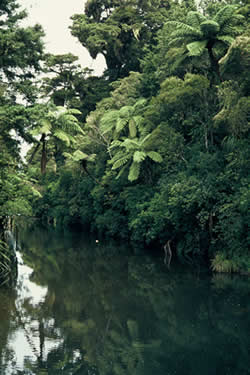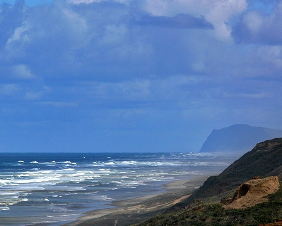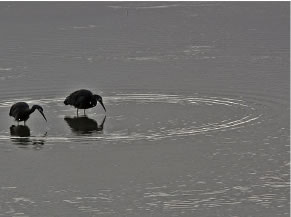Management issues: Biodiversity
Introduction
Biodiversity, nga koiora rereketanga, is the diversity in number and variety of living (non–human) organisms. It includes diversity of species, between species, and of ecosystems and the processes that maintain them.
 |
 |
| Trounson Kauri Park, situated in the northern part of the Kaipara catchment (Source: DOC) |
Maunganui Bluff (Photo: © Jan Doak) |
The Kaipara has been transformed from primeval forest, scrub and wetlands to pasture. It fed the NZ and Australian timber industry from 1860s to 1900s (peak was 1899 and trade ceased about 1939). Supplied kauri gum and flax for building everything and anything in colonial NZ. And today, sand for the entire Auckland region. There is no doubt that the removal of the bush did have severe consequences on biodiversity. Soil erosion accelerated on the land around the harbour, as did sedimentation in parts of the harbour. This has altered the biodiversity of marine habitats substantially.
The people of the Kaipara have observed declines in shellfish beds, especially scallops, toheroa, pipi, tuatua, cockle; declines in finfish, such as snapper, school shark, mullet kanae; habitats such as sand flats, riparian vegetation, kauri and kahikatea forests, coastal dune vegetation and wetlands.
A traditional relationship exists between Kaipara Maori and New Zealand’s indigenous biodiversity and remains an important part of the lives of Kaipara Maori. Biodiversity is crucial to the Kaipara Maori not only because of their traditional use but is treasured. They are Kaitiaki for the biodiversity and holders of traditional tribal management. Like many indigenous societies Kaipara Maori depend on a limited resource. Unfortunately, the Kaipara Maori has virtually little involvement in aspects of biodiversity management such as conservation, customary and commercial use.

Heron duo (© Jan Doak)
Traditional Maori knowledge or Matâuranga Mâori, about New Zealand’s biodiversity is an important source of knowledge, but is currently under–utilised and vulnerable to ongoing erosion and loss and therefore its recognition, constant use and protection is central to Maori participation in biodiversity management.
No information on the status and extent of marine and estuarine biodiversity, including coastal habitats, exists for the Kaipara. A recent reconnaissance survey undertaken for the Otamatea Ecological District states that estuarine habitat is still extensive, however only 9.75% of the land cover is indigenous vegetation or wetland.
The physical and legal protection of priority areas for biodiversity protection would constitute an important step in safeguarding remaining indigenous biodiversity. However, even if all priority areas were protected, there would still be a need for ecological restoration of additional corridors, linkages and buffers to provide better connectivity between natural areas to ensure ecosystem, genetic and species biodiversity recovery.
References:
- Ogle, C.C. (1982). Wildlife and Wildlife Values of Northland. NZ Wildlife Service Department of Internal Affairs. Fauna Survey Unit Report No. 30. 272pp.
- Beever, J. (1981). A map of the Pre–European vegetation of Lower Northland, New Zealand. NZ J Bot. 19:105–110.
- Lux, J., and Beadel, S. M. (2006). Natural Areas of Otamatea Ecological District: reconnaissance survey report for the Protected Natural Area Program. Wildlands Consultants Ltd. Published by Department of Conservation, Northland Conservancy. 512p.
- Hewitt, J.E., and Funnell, G.A. 2005. Benthic marine habitats and communities of the southern Kaipara. NIWA, Hamilton. Prepared for Auckland Regional Council. 74p.
Related publications
| Year |
Author |
Title |
Type |
Size |
| 2011 |
Oremus, M., Stanley, M., Constantine, R., Hamner, R.,Baker, S. |
Estimating the abundance and effective population size of Maui dolphins using microsatellite genotypes: report on the 2011 biopsy sampling survey.
|
 |
676 KB |
| 2011 |
Morrison, M |
Wananga Workshop Presentation: NIWA fish–habitat focused research programs: efforts in the Kaipara Harbour
|
 |
6.8 MB |
| 2010 |
IKHMG |
Information Review & Gap Analysis. The Kaipara Atlas: An Integrated Database.
|
 |
15.5 MB |
| 2010 |
Department of Conservation |
New Zealand Coastal Policy Statement 2010, December 2010
|
 |
509 KB |
| 2010 |
Parkyn, S et al. |
The Restoration Indicator Toolkit:indicators for monitoring the ecological success of stream restoration.
|
 |
14.8 MB |
| 2010 |
IKHMG |
The World of Kaipara. Information Review & Gap Analysis. Chapter 1 to 8. Purpose, Introduction, Historical Background and Methodology.
|
 |
1.6 MB |
| 2010 |
IKHMG |
The World of Kaipara. Information Review & Gap Analysis. Chapter 10. Restoring Sustainable Use of Fish & Invertebrate Stocks.
|
 |
3.1 MB |
| 2010 |
IKHMG |
The World of Kaipara. Information Review & Gap Analysis. Chapter 11. Restoring the Mauri of Kaipara.
|
 |
2 MB |
| 2010 |
IKHMG |
The World of Kaipara. Information Review & Gap Analysis. Chapter 14. Integrated and Co–operative management of Kaipara ecosystems, harbour and catchment.
|
 |
2 MB |
| 2010 |
IKHMG |
The World of Kaipara. Information Review & Gap Analysis. Chapter 15. Discussion.
|
 |
276 KB |
| 2010 |
IKHMG |
The World of Kaipara. Information Review & Gap Analysis. Chapter 16. Appendix.
|
 |
2.1 MB |
| 2010 |
IKHMG |
The World of Kaipara. Information Review & Gap Analysis. Chapter 9. Protecting & Restoring Native Biodiversity.
|
 |
9.7 MB |
| 2010 |
IKHMG |
The World of Kaipara. Information Review & Gap Analysis. Executive Summary.
|
 |
1.6 MB |
| 2009 |
Morrison M, Lowe M, Parsons D, Usmar N, McLeod I |
A review of land-based effects on coastal fisheries and supporting biodiversity in New Zealand. New Zealand Aquatic Environment and Biodiversity Report No. 37, 2009. 102 pp.
|
 |
5.5 MB |
| 2009 |
Kench, P., Hosking, P., and D Jenkinson |
Kaipara Harbour Coastal Monitoring Program. 2008 Annual Report. Auckland Uniservices Ltd. 48p.
|
 |
5.7 MB |
| 2008 |
Ministry for Environment |
Coastal Hazards and Climate Change. A Guidance Manual for Local Government in New Zealand. 2nd Edition. 139 p.
|
 |
4.8 MB |
| 2008 |
Haggit T, Mead S, and M Bellingham |
Kaipara Harbour Environmental Information Review. ARC Technical Publication TP 354.
|
 |
7.2 MB |
| 2008 |
Bellingham, M., and A., Davis. |
Stock Grazing Impacts on Estuarine Vegetation in the Southern Kaipara Harbour
|
 |
5.6 MB |
| 2007 |
Ministry for the Environment |
Environment New Zealand 2007 |
 |
|
| 2007 |
Scarsbrook, M. |
River water quality. State and trends in the Auckland Region. Auckland Regional Council Technical Publication No. 336, 2007. 48pp.
|
 |
1 MB |
| 2005 |
Morrison, M. |
An information review of the natural marine features and ecology of Northland. Prepared for Department of Conservation.
|
 |
12.2 MB |
| 2005 |
Hewitt, J.E., and Funnell, G.A. |
Benthic marine habitats and communities of the southern Kaipara.
|
 |
2.9 MB |
| 2005 |
Unknown |
Marine Communities.
|
 |
211 KB |
| 2004 |
Froude, V.A., Smith, R. |
Area-based restrictions in the New Zealand marine environment. |
 |
|
| 2004 |
Marjorie van Room
Stephen Knight |
Ecological Context of Development
New Zealand Perspectives |
 |
|
| 2004 |
Grave, R V |
Kaipara Harbour Sand Extraction. Fitzgerald Bank Biological Monitoring. Report prepared for Winstone Aggregates Ltd & Mt Rex Shipping Ltd.
|
 |
2.3 MB |
| 2003 |
Ferreira, S M., and C C Roberts |
Distribution and abundance of Maui dolphin (Cephalorhynchus hectori maui) along the North Island west coast, New Zealand. DOC Science Internal Series 93. 18p.
|
 |
222 KB |
| 2003 |
Ministry of Fisheries |
Strategic Plan 2003-2008 |
 |
|
| 2002 |
Davis, A. |
Kaipara Ecological District: Ecological character, threats and management needs. Final Report.Draft Two. June 2002. 184p.
|
 |
4.8 MB |
| 2002 |
Davis, A. |
Otamatea Ecological District: Ecological character, threats and management needs. Final Report. Draft Two. June 2002. Aristos Consultants. 125pp.
|
 |
2.5 MB |
| 1999 |
Hayward B, Grenfell H, Scott D |
Tidal range of marsh foraminifera for determining former sea–level heights in New Zealand
|
 |
3.3 MB |
| 1981 |
Beever, J |
A map of the Pre–European vegetation of Lower Northland, New Zealand
|
 |
1.1 MB |
| 1976 |
Hayward, B W |
Spirula (Sepioidea: Cephalopoda) from the Lower Miocene of Kaipara Harbour, New Zealand
|
 |
1.1 MB |
| 1975 |
Schofield, J.C. |
Sea-level fluctuations cause periodic, post-glacial progradation, south Kaipara barrier, North Island, New Zealand. NZ J Geology and Geophysics. 18(2):295-316
|
 |
1.1 MB |
| |



